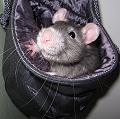» Site Navigation

0 members and 596 guests
No Members online
Most users ever online was 47,180, 07-16-2025 at 05:30 PM.
» Today's Birthdays

» Stats

Members: 75,905
Threads: 249,105
Posts: 2,572,114
Top Poster: JLC (31,651)
|
-
-
-
This may or may not help you, but I find it interesting so I'm going to share any way. 
On a microscopic level, mink is actually a dilution of black pigment to brown. You can see this in a basic microscope. Depending on the "quality" of the mink, you'll see different shades of brown, or sometimes even black pigment.
In contrast, blue is not a dilution of pigment, but actually a redistribution of pigment. For both kinds of blue (American blue vs. Russian blue), the pigment is actually black. In American blue, the pigment is distributed evenly throughout the hair shaft. In Russian blue, the pigment is distributed unevenly. There can be some slight variation, but in general these are the rules. This uneven distribution of black pigment is what gives Russian blue its "heathered" or "ticked" look (note: this is not true ticking as seen in agouti where there are different bands of color, it is just different shades of gray varied throughout the hair shaft).
So if you look at the following horizontal lines, using "*" to represent pigment "granules", this is what you'd see in a microscope for the two blues.
American blue:
** ** ** ** ** ** ** ** ** ** **
Russian blue:
** * ** * * * ** * * ** * * ** * * **
Does that make sense? You can see how in the American blue the pigment granules are clumped together fairly evenly and consistently, where the Russian blue pigment granules are clumped unevenly and inconsistently.
Genetically Russian blue is described as "d" for "dilute" and American blue is described as "g" for "gray". The term "dilute" only refers to the overall appearance, because the gene does not actually dilute the pigment itself. In the UK different symbols are used, where American/UK (same thing) blue is described as "d" for dilute, and Russian blue is described as "rb" for Russian Blue.
Both blues will ALWAYS have black eyes. However some mink will have ruby eyes. In my personal breeding program, I have found that UK mink tends to have black eyes, where American mink tends to have ruby eyes. The more modifiers an American mink carries, the lighter their eyes. American mink without any dilutes can have extremely dark eyes, appearing black even. The American mink and UK mink are actually genetically distinct too, and both cause the fur to be diluted to a "brown" shade. Both exist in the US, though American mink tends to be more common. In my experience, UK mink tends more toward gray, where American mink tends more toward brown. Both are variable in shade, though American mink tends to be much more reactive to carried genes and modifiers. An unmodified American mink can be very dark, almost resembling chocolate (which is another distinct brown gene). There is possibly another "brown" gene, often called "Aussie mink" because it was first discovered in Australian rats. This gene is very rare in the US though.
Clear as mud? hehe
Why keep a snake? Why keep any animal? Because you enjoy the animal, find something beautiful and fascinating about it, and it fits seamlessly into your lifestyle.
-
The Following 2 Users Say Thank You to sorraia For This Useful Post:
Inasailorsgrave (10-30-2013),satomi325 (10-31-2013)
-
Registered User


Actually what you say makes a lot of sense, I mean I've done rat genetics research before I even got rats, but to be honest blues and minks always stumped me and this is the first time It actually made sense, so I thank you for that. Thanks alot 
-
-
Re: Mink vs blue?
 Originally Posted by Inasailorsgrave

Actually what you say makes a lot of sense, I mean I've done rat genetics research before I even got rats, but to be honest blues and minks always stumped me and this is the first time It actually made sense, so I thank you for that. Thanks alot 
Glad it made sense! Once you see enough animals and learn the characteristics to look for, it gets easier, even when you get combinations. Kind of like ball pythons. Having bred rats for so long, I can identify most colors and combinations (there are exceptions), but I feel totally lost when it comes to ball pythons. I'm picking up the characteristics of some of the morphs, but a lot of them look the same to me! lol
Why keep a snake? Why keep any animal? Because you enjoy the animal, find something beautiful and fascinating about it, and it fits seamlessly into your lifestyle.
-
The Following User Says Thank You to sorraia For This Useful Post:
-
Re: Mink vs blue?
See! Told yah she knows her rat stuff!
Sent from my DROID RAZR using Tapatalk 2
-
The Following 2 Users Say Thank You to satomi325 For This Useful Post:
Inasailorsgrave (11-05-2013),sorraia (10-31-2013)
 Posting Permissions
Posting Permissions
- You may not post new threads
- You may not post replies
- You may not post attachments
- You may not edit your posts
-
Forum Rules
|
